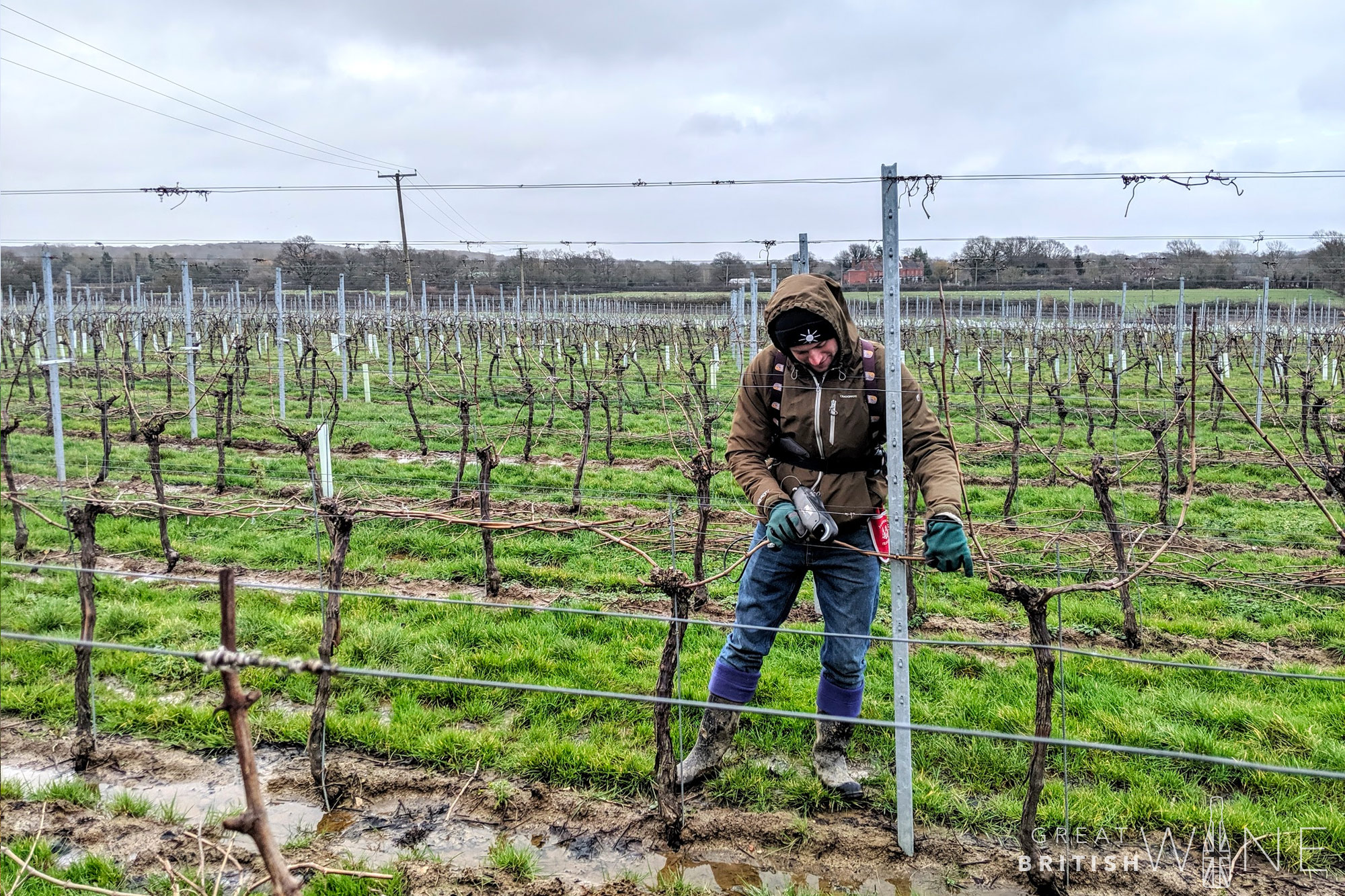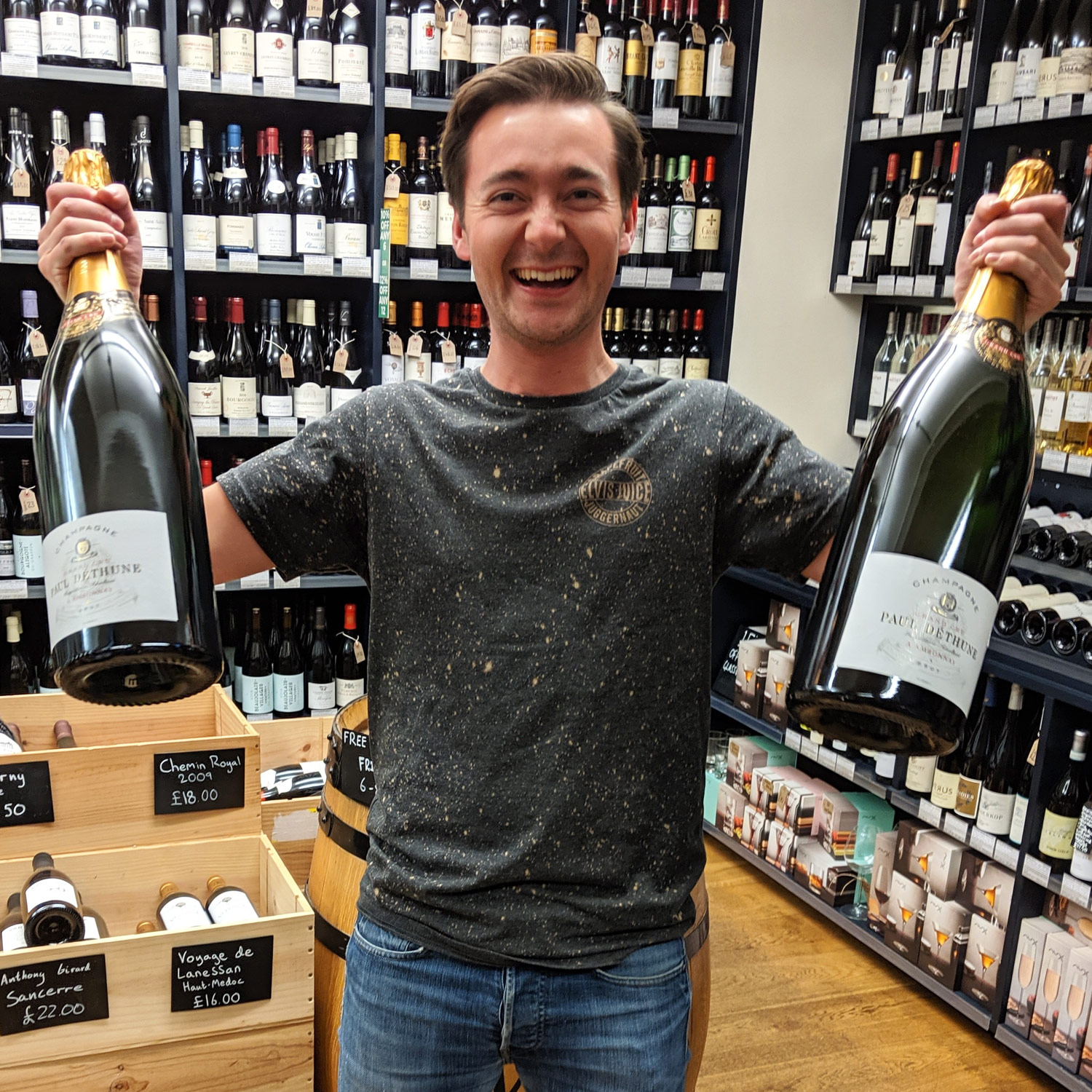“Would you like to borrow a pair of wellies?”, Howard asked, in an affable but mildly concerned tone, as he stared down at our clean, brightly coloured trainers. I declined. I regretted declining. Like most agricultural land, vineyards can be muddy places, especially after two storms in as many weeks.
Locked down in London, I’ve found myself thinking back to my slightly muddy February trip to Sussex. Despite the fact that it is getting sunnier and warmer by the day, I’d trade it all for a bit of mud on my boots! So, take a trip with me, to two of Sussex’s most exciting vineyards…
Breaky Bottom
The drive to Breaky Bottom is not for the faint of heart – it’s located at the end of a mile-long farm track that alternates between small potholes and…large potholes. The only clue that you’re headed in the right direction is a small sign, located just before a cattle grid, that declares, “Breaky Bottom: Visits by Appointment”.

But for those with comprehensive rental car insurance, and a little faith, the track eventually reveals a hidden hollow, at the base of which sits Breaky Bottom. This is the home, winery and estate of Peter Hall.
Two things have made Peter something of a cult figure in the English winemaking scene. The first is that he’s been doing it a while. In an industry dominated by post-recession city refugees, Peter’s four decades of experience lends him a certain aura. Like any veteran winemaker, Peter has an uncanny ability to remember weather events stretching far into the past.
The second is his expansive personality. As we arrive, he declares that he is incredibly busy fighting a legal battle to protect his vineyards from swarms of pheasants. But, despite an incessantly ringing telephone, we end up chatting to Peter for almost two hours.
The combination of these two characteristics makes Peter a natural storyteller. His tales take us from Sussex to his grandfather’s Soho restaurant, Le Petit Savoyard, where the great and the good were smuggled in and out of the back door to avoid the paparazzi. His cuvées are named after people special to Peter, and each is invariably accompanied by an enchanting tale of a life well lived and a person sorely missed.
During our visit, we sample three of his wines. The first is the delightfully fresh Seyval Blanc, Peter Christiansen, named after a renowned space physicist at the University of Sussex. The second is the riper Michelle Moreau, a 2014 Champagne blend, named after another dear friend. Michelle was a widely travelled writer, poet and dancer, and was the sister of the ‘grand dame’, actress Jeanne Moreau. We finish with the 2010 Reynold Stone, named after the renowned engraver whose work includes Winston Churchill’s memorial, the coat of arms that is reproduced on every British passport and, of course, Breaky Bottom’s simple typeface.
While our visit to Breaky Bottom didn’t involve any sort of fancy tasting room or tour of a flashy winery, it didn’t need it. The splendid isolation of the hollow, the terrific wines and engrossing stories made this a moment I’ll remember for a very long time to come.
Cuvée Peter Christiansen 2014
Grapes: Seyval Blanc
This wine is made using the traditional method, and does not undergo any malolactic fermentation in order to keep the focus on the grape’s tart acidity and fresh fruit flavours.
The nose is fresh and fruit-forward, with intense flavours of crunchy Granny Smith apple and lemon zest. There is just a hint of autolytic, yeasty flavour, but the star of the show is the crisp fruit.
The palate has tart acidity and lots more fresh green and citrus fruit flavours. But the wine isn’t sharp at all, the result of extended lees ageing which lends the palate texture and weight.
With warmer weather just around the corner, this will be perfect for a summer barbeque or lazy park picnic. Not that many of those will happen this summer. Fortunately, I believe this wine will have a lot to offer with age!
Cuvée Michelle Moreau 2014
Grapes: Chardonnay (70%), Pinot Noir (15%), Pinot Meunier (15%)
Breaky Bottom’s latest release of its classic Champagne blend has a nose of ripe orchard fruit and citrus fruit, with a layering of brioche and just a hint of fresh stone fruit.
The palate is noticeably richer than the Seyval. The acidity is lively but the wine feels more textured and weighty than the Christiansen. There are more ripe fruit flavours and a healthy dollop of autolytic breadiness to top it off.
It’s an altogether different experience from the Christiansen. The flavours are riper and the structure is fuller-bodied. This makes the Moreau more suited to pairing with richer foods.
Court Garden
A short drive north, past Plumpton College and through the frustratingly narrow streets of Ditchling, brings you to Court Garden. This family-run estate began life in 2005, and has grown to encompass 17 acres of the South Downs. It originally began life as a sheep farm, but an outbreak of foot-and-mouth gave its founder, Howard, second thoughts. He decided instead to try his hand at winemaking.
15 years on and there is still a small flock of sheep to remind us of the vineyard’s origins. While they do lend a help handing and trimming foliage after harvest, the focus is now firmly on the grapes. We visit just after the completion of winter pruning, the fiddly task of selecting the most promising shoots, now hardened wood, and chopping off the rest.
As we chat with Howard, a small team of vineyard workers bend the vines’ canes and tie them against the trellis. This will ensure that the vines’ new shoots will grow upwards, maximising their exposure to sun and helping to prevent disease. It’s difficult to fully grasp how complicated growing grapes can be until you see these dedicated professionals at work.
Court Garden’s winery looks down over the vineyards. From this perch, Hugo, the estate’s winemaker, spoke passionately about the advantages of working fruit grown on their own estate. Using only estate-grown fruit gives Court Garden complete control from soil to bottle (weather excepted) and ensures that the grapes arrive at the winery as fresh as possible. This is not as common as you might think. The large capital investment involved in building a winery means that many growers actually rely on the facilities of nearby wineries.
Court Garden grows a large range of varieties including Pinot Gris, Ortega, Rondo and Pinot Blanc. But 80% of the grapes are the Champagne varieties, and their focus remains on sparkling wine. I was especially impressed by their 2015 Classic Cuvée which is rich with a distinctive aroma of apple pie, and their 2014 Rosé which has a perfect balance between red berries, citrus and pastry flavours.
When the days are short and the skies grey, a trip out into wine country might not have immediate appeal. But it can be a rewarding experience. The vineyard is in an important stage of its life cycle, winemakers tend to have a wee bit more time to share their knowledge with visitors, and the bracing wind will make you appreciate a glass of English fizz all the more!
Court Garden Classic Cuvée 2015
Grapes: Chardonnay (41%), Pinot Noir (32%), Pinot Meunier (27%)
The nose strikes a satisfying balance between fruit and autolytic flavours. Fresh orchard fruit, lemon and some stone fruit are set against a pleasantly rich toastiness from extended lees ageing.
The palate is fresh, with plenty of lemon and stone fruit flavours, and a good dose of toasty richness.
This is the perfect introduction to English sparkling wine. It’s fresh but has a lovely bit of richness thanks to the inclusion of a small percentage of 2014 reserve wine. It’s made in a timeless fashion and, at only £26 a bottle, is an absolute bargain.
Court Garden Rosé 2014
Grapes: Chardonnay (41%), Pinot Noir (32%), Pinot Meunier (27%)
This was my favourite of the wines I tried at Court Garden. The nose is an intense mixture of fresh red berries and citrus fruit, with quite pronounced autolytic flavours of pastry and biscuit – think strawberry cheesecake in a glass.
The palate is rich. Rich red fruit and biscuit flavours are complemented by a creamy texture and balanced by fresh acidity.
Once again, this is excellent value at just under £28 a bottle. It’s a very good example of English sparkling rosé and the generous wines produced from the warm 2014 vintage.








Very much enjoyed this, thank you.
Thanks Andy, would definitely recommend getting out there later in the year!
Pingback: This Week’s Latest Wine Headlines: May 10—May 15 – Briscoe Bites